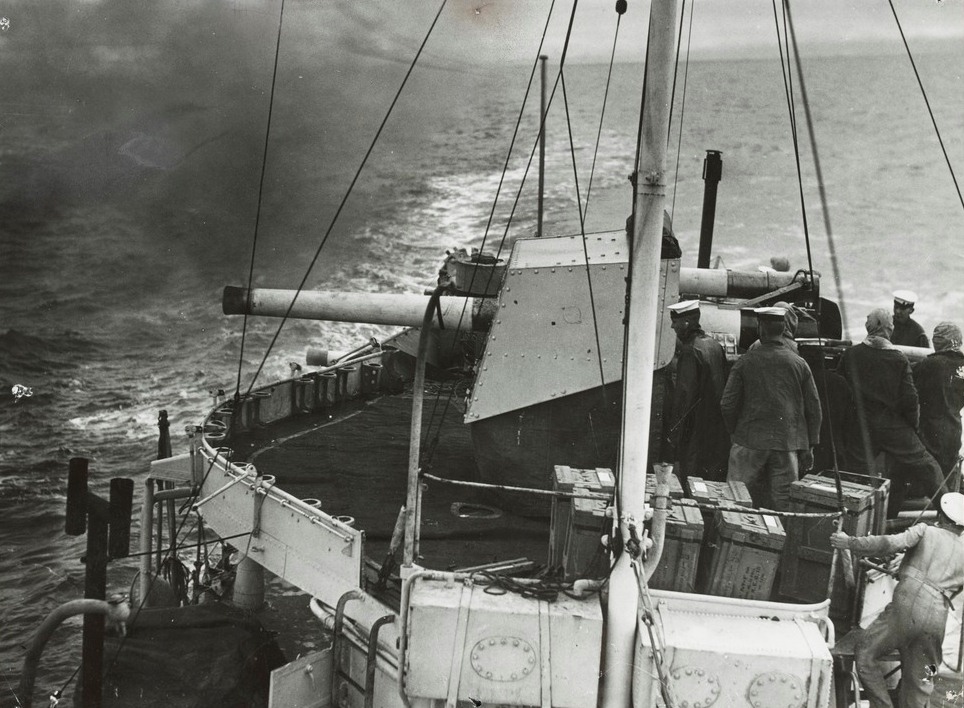
The Mark V was first introduced as a low angle weapon on HMS Arethusa in 1914 and it was later chosen for use as an AAA gun near the end of World War I. During the period just prior to World War I, the Admiralty decided to change the main armament for destroyers and cruisers away from bag guns (BL) over to quick firing guns (QF). QF guns had a higher rate of fire than did BL guns, an important factor for warships intended to be used in short range battles with enemy destroyers.
During the Battle of Heligoland Bight in 1914 HMS Arethusa lost the use of all of her 4" (10.2 cm) guns for a time due to problems with the cartridge ejectors. Her crew was eventually able to restore all but two of these guns to action.
Up until the late 1930s the Mark V was the main British long-range AA weapon and was fitted in a majority of capital ships and cruisers. Most ships fired fixed ammunition, but the World War I cruisers and "V" and "W" class destroyers fired separate ammunition. Still used in large numbers during World War II with many new guns being manufactured. Guns removed from capital ships and cruisers in the 1930s were reused on many warships during World War II, including seven "P" class and four "O" class destroyers. Also issued as star-shell guns in some Dido class cruisers and early "Battle" class destroyers.
The original Mark V was constructed of a tapered inner A tube, A tube, taper wound wire, full-length jacket and breech ring. Used a horizontal sliding breech block, opening to the right, with semi-automatic action. Mark V* had no inner A tube. An "A" added to either Mark V or Mark V* indicated a strengthened bolt actuating. Mark V** had a heavy autofretted loose liner with a muzzle bush on the jacket and a removable breech ring. This mod was used for repairing guns in 1937. Mark V*** differed in detail and had a sealing ring instead of a muzzle bush, and its liner could be changed on board. The Mark VB was the intended new loose liner gun, but none appear to have been completed. The final version, the Mark VC built during World War II, had a loose barrel, changeable on board, a shorter jacket, removable breech ring and sealing collar. Altogether 283 Mark VC and 554 earlier types were made for the Navy with about 107 additional guns being manufactured for the Army, where they were used as AA and coastal defense guns during World War I. Of these, 83 were later transferred to the Navy. Of the 637 earlier guns in naval service, 601 remained in 1939.
The Mark V or a close variation was also used on the Argentine training cruiser La Argentina.
The Mark XV was an experimental weapon with the same performance characteristics as the Mark V but with a vertically sliding breech block. Two Mark V guns were modified to use this breech mechanism and these were used in the prototype of the between decks (BD) twin mounting which was installed on HMS Resolution for trials in 1931. Six new Mark XV guns were manufactured, with four being installed in two new BD twin mountings on HMS Repulse in 1936. However, these guns proved to have an unacceptably low rate of fire and the mountings were removed from Repulse in 1938. The BD concept was further developed and was later successfully used with 4.5"/45 (11.4 cm) guns.
The data that follows below is for the Mark V unless otherwise stated, but the Mark XV should have had similar performance as the fixed ammunition Mark V.
| Designation | 4"/45 (10.2 cm) QF Mark V
4"/45 (10.2 cm) QF Mark XV |
|---|---|
| Ship Class Used On | Mark V
Most cruisers and capital ships 1914 - 1937 Many smaller ships during both World Wars Mark XV
|
| Date Of Design | Mark V: About 1913
Mark XV: 1930 |
| Date In Service | Mark V: 1914
Mark XV: 1931 (experimental prototype) and 1936 (production prototypes) |
| Gun Weight | Fixed ammunition guns except Mark VC: N/A
Separate ammunition guns: 2.138 tons (2.172 mt) Mark VC: 2.171 tons (2.206 mt) |
| Gun Length oa | 187.8 in (4.770 m) |
| Bore Length | 180.0 in (4.572 m) |
| Rifling Length | 149.7 in (3.803 m) |
| Grooves | (32) 0.037 in deep x 0.270 (0.94 x 6.86 mm) |
| Lands | 0.1227 in (3.117 mm) |
| Twist | Uniform RH 1 in 30 |
| Chamber Volume | Fixed ammunition: 447 in3 (7.325 dm3)
Separate ammunition: 464 in3 (7.604 dm3) |
| Rate Of Fire | Mark V variants: 10 - 15 rounds per minute (14 rounds per minute @ 50 degrees elevation)
Mark XV: 9 rounds per minute |
| Type | Produced in both Fixed and Separate versions |
|---|---|
| Weight of Complete Round | HE: 53.5 lbs. (24.26 kg)
SAP: 56 lbs. (25.4 kg) Shrapnel: N/A |
| Projectile Types and Weights | HE: 31 lbs. (14.06 kg)
SAP: 33.5 lbs. (15.2 kg) Shrapnel: N/A |
| Bursting Charge | HE: 1.8 lbs. (0.82 kg)
Others: N/A |
| Projectile Length | HE: 17.5 in (44.45 cm) 1 Others: N/A |
| Propellant Charge 2 | Fixed: 6.1 lbs. (2.76 kg) SC061 or 7.3 lbs. (3.32 kg) NF/S116-036
Separate: 7.69 lbs. (3.49 kg) MD16 or 7.9 lbs. (3.59 kg) SC103 or 9.4 lbs. (4.25 kg) NF/S165-048 Cartridge: 22.5 lbs. (10.2 kg) |
| Muzzle Velocity 3 | Fixed 31 lbs. (14.06 kg) HE: 2,387 fps (728 mps)
Separate 31 lbs. (14.06 kg) HE: 2,642 fps (805 mps) |
| Working Pressure | 18.5 tons/in2 (2,910 kg/cm2) |
| Approximate Barrel Life | Fixed: 850 rounds
Separate: 600 rounds |
| Magazine capacity per gun 4 | Arethusa [1914] class: 200 rounds
Caroline class: 200 rounds Emerald class: 150 rounds Capital Ships: 150 rounds County class: 200 rounds York class: 150 rounds Leander class: 250 rounds Modified Leander class: 200 rounds Arethusa [1935] class: 200 rounds Small ships: about 150 rounds |
- ^HE used during World War I was 3crh while that used during World War II was 4.38/6crh.
- ^The LA guns of the World War I era all used separate ammunition while the HA guns used fixed ammunition. LA guns built after World War I used fixed ammunition.
- ^The sources below differ as to the muzzle velocity of these weapons. I have chosen to use those given in "Naval Weapons of World War Two."
- ^Outfits included SAP, HE, shrapnel and star shells.
- In 1931 it was estimated that the HE shell for this gun against aircraft had a lethal volume 30 feet long by 51 feet in diameter (9 x 16 m).
| Elevation | Distance |
|---|---|
| 45 degrees | 16,300 yards (14,950 m) |
| AA Ceiling @ 80 degrees | 28,750 feet (8,763 m) |
| Elevation | Distance |
|---|---|
| 44 degrees | 16,430 yards (15,020 m) |
| AA Ceiling @ 80 degrees | 31,000 feet (9,450 m) |
| Designation 1a 2a 3a | Mark V Guns - Open Single Mounts
Arethusa [1914] (6), Caroline (8), Calliope (8) and Cambrian (8): PX Mark I "V" (4) and "W" (4) Destroyers: LA CP Mark II Sloops and patrol boats of the 1920s: LA CP Mark II Hood (4), Emerald (3), Kent (4) and London (4): HA Mark III or Mark III* or Mark III** 4a Dorsetshire (4), York (4), Leander (4), Modified Leander (4), Arethusa [1935] (4): HA Mark IV 4a Destroyers "O" (5) and "P" (4 or 5): HA Mark III or HA Mark IV 4a Mark XV Guns - Twin Mount 5a |
|---|---|
| Weight | PX Mark I: N/A
CP Mark II: 5.3 tons (5.4 mt) HA Mark III and IV: 7.0 tons (7.1 mt) without shields BD Mark XVII: N/A BD Mark XVIII: N/A |
| Elevation | PX Mark I: -10 / +20 degrees (some may have been later modified to +30 degrees)
CP Mark II: -10 / +30 degrees HA Mark I: -5 (?) / +60 degrees HA Mark III, III*, III** and IV: -5 / +80 degrees BD Mark XVII: -5 (?) / +85 degrees BD Mark XVIII: -5 (?) / +85 degrees |
| Elevation Rate | Single Mountings: Manually operated, only
Twin Mountings: N/A |
| Train | Single Mountings: 360 degrees
Twin Mountings: N/A |
| Train Rate | Single Mountings: Manually operated, only
Twin Mountings: N/A |
| Gun recoil | 15 in (38 cm) |
- ^CP Mark II mountings used on small vessels built after the war used fixed ammunition.
- ^The LA guns of the World War I era all used separate ammunition.
- ^All HA guns used fixed ammunition.
- ^4.14.24.3The single HA mountings were all generally similar, the main differences being in the fuze setting platform position and the design of the recoil and run-out cylinders. Mark III used a hydro-pneumatic run-out cylinder, which proved unsuccessful, and two small platforms on each side of the trunnion supports. Mark III* was a modification using an all pneumatic run-out cylinder. Mark III** had a pair of run-out springs in large twin cylinders above the gun cradle and a dual manual fuze-setting platform on the left side. The Mark IV was used mainly on "Country" class cruisers and had an improved pneumatic run-out cylinder, also known as a "recuperator," and a mechanical fuze-setting machine on the left side.
- ^The guns in the twin mountings shared the same cradle.
- During the 1920s AA weapons were given a complex HA geared gunsight, but this was never very successful and was removed with the introduction of the HACS Mark I. Later, a simple optical sight for local surface control was fitted to most guns.
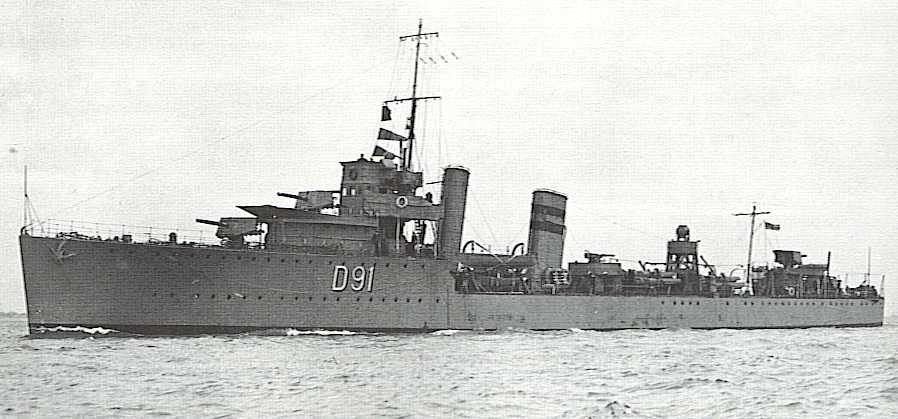
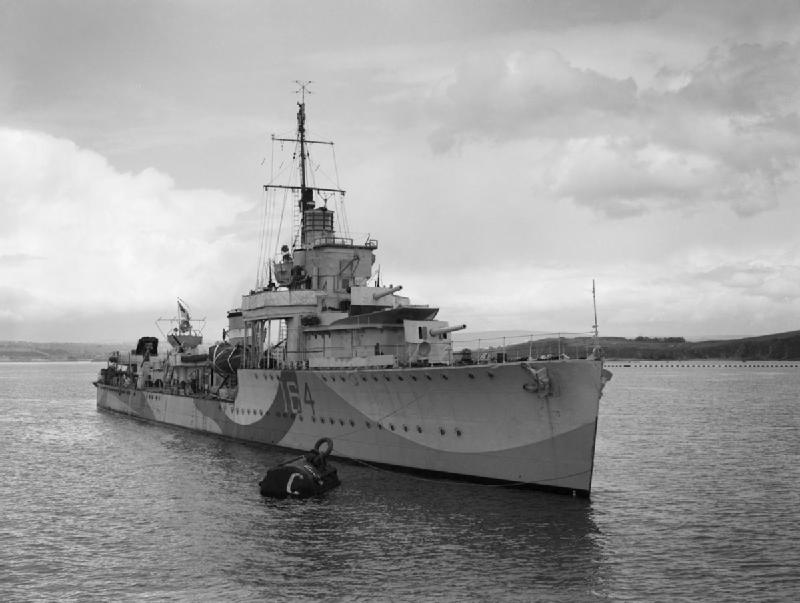
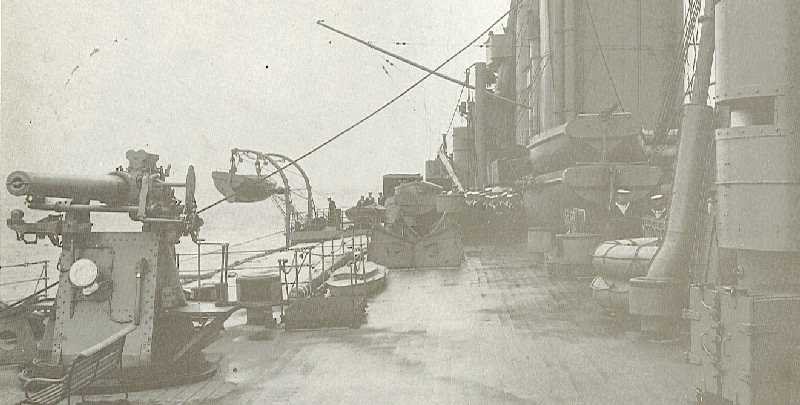
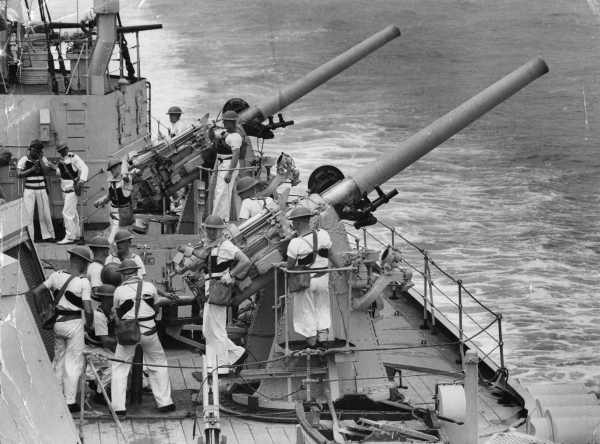
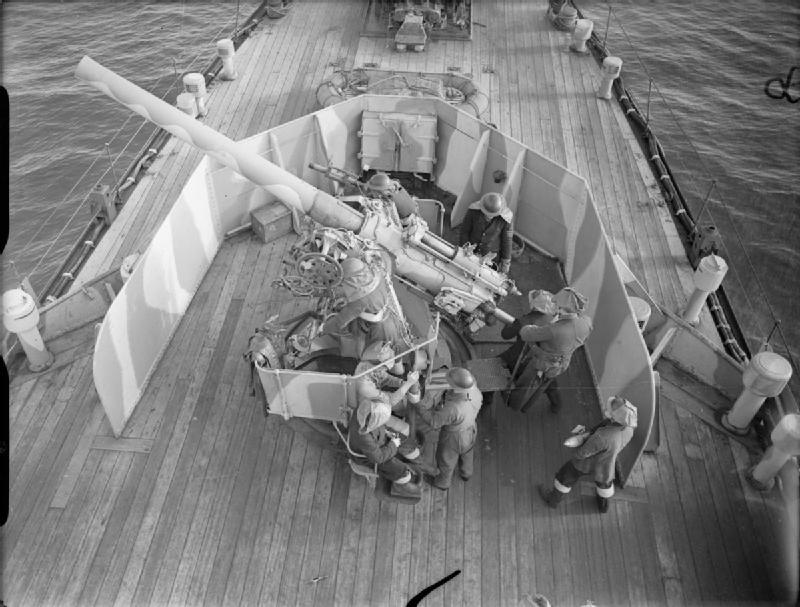

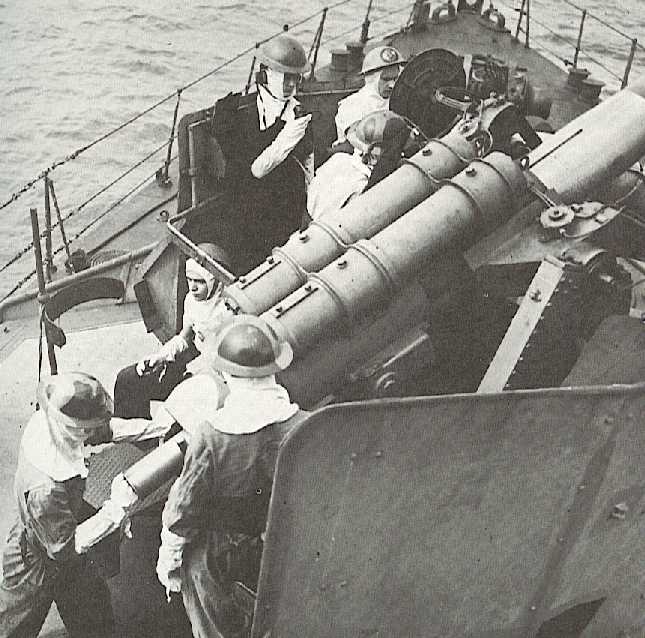
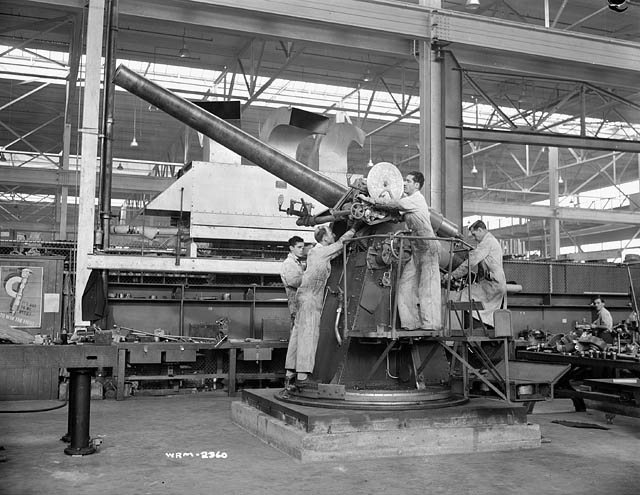
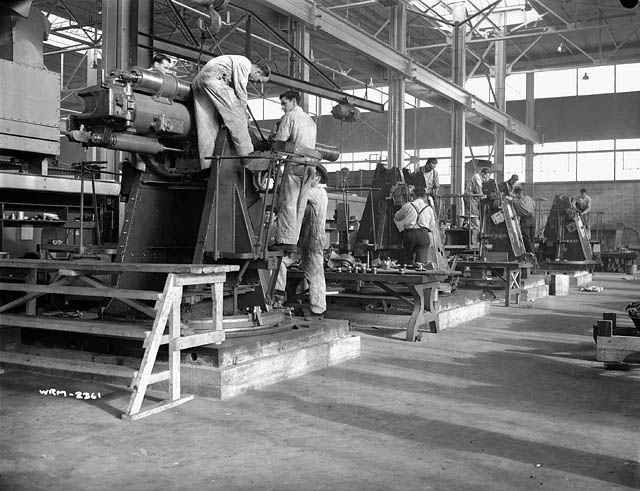
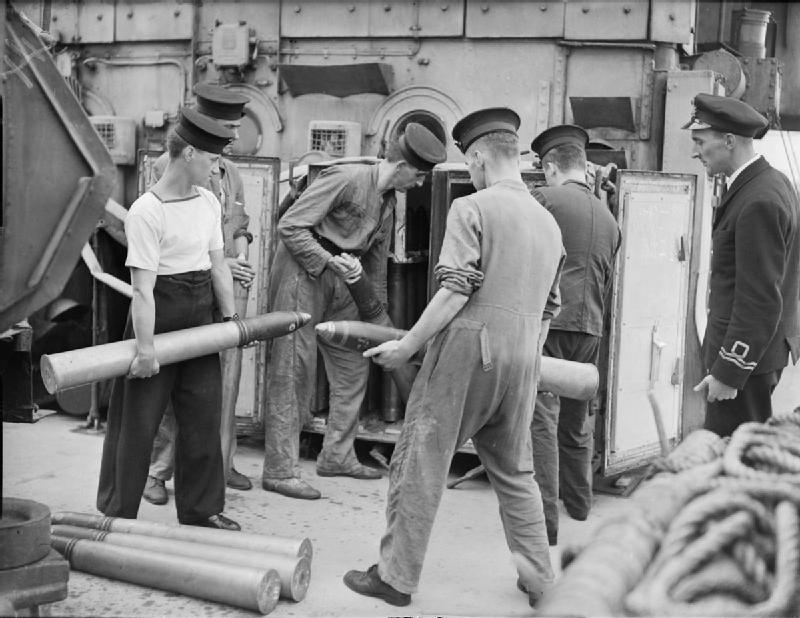
The Vickers Photographic Archive
Mark XV: See photographs 4819,
4820,
4821 and
4833
Photograph 4833 is incorrectly identified as a 4.7" (12 cm) mounting
Australian War Memorial
4"/45 (10.2 cm) Mark V gun on HMAS Australia
"Nelson to Vanguard: Warship Design and Development 1923-1945" by D.K. Brown
"Naval Weapons of World War Two" and "British Naval Guns 1880-1945 No 18" article in "Warship Volume X" both by John Campbell
"Destroyer Weapons of World War 2" by Peter Hodges and Norman Friedman
"British Battleships of World War Two" and "British Cruisers of World War Two" both by Alan Raven and John Roberts
"Anatomy of the Ship: The Battlecruiser Hood" by John Roberts
---
Special help from Georg v. Rauch
14 October 2008 - Benchmark
25 January 2010 - Added pictures of Dominion guns, recropped picture of HMS York to show USS Macon
15 December 2013 - Added photograph of HMS Weston
03 February 2014 - Added photograph of HMS Widgeon
25 May 2014 - Added photograph of HMS Viceroy
29 November 2015 - Changed Vickers Photographic Archive links to point at Wayback Archive
18 October 2017 - Converted to HTML 5 format, added photograph of Vansittart
06 November 2021 - Reorganized notes and minor updates to the current template
